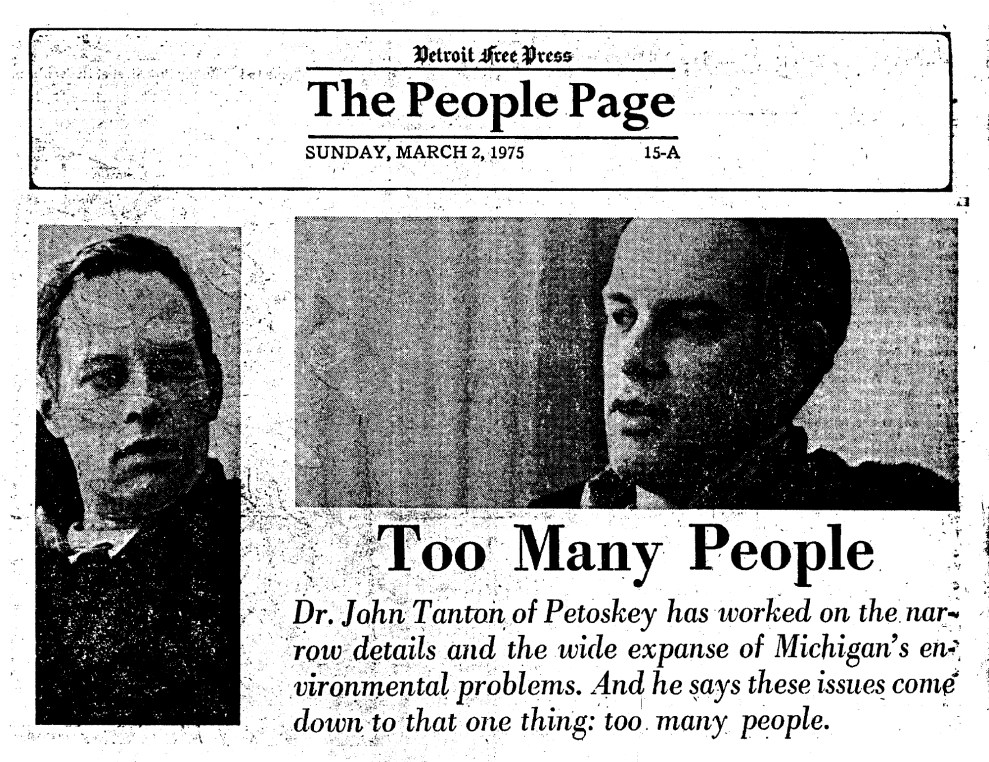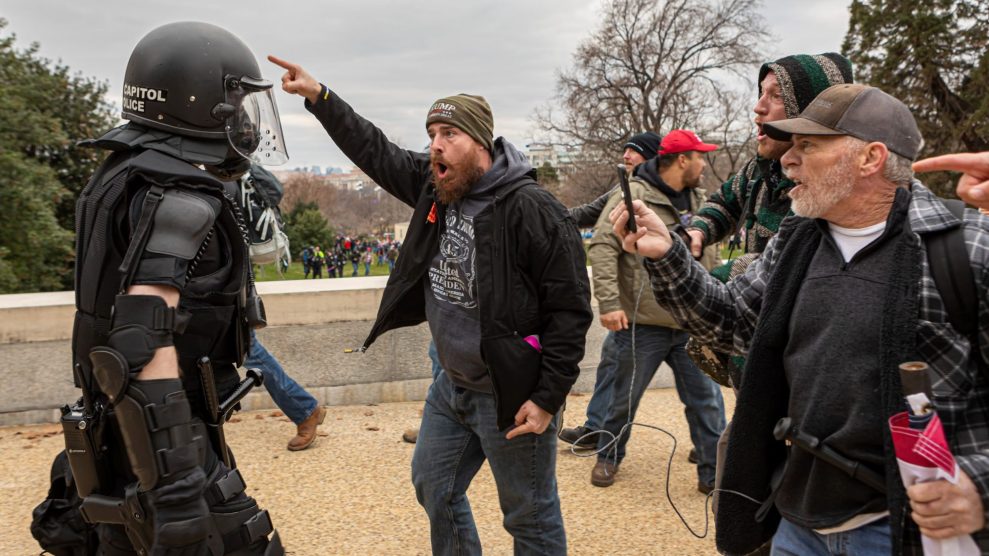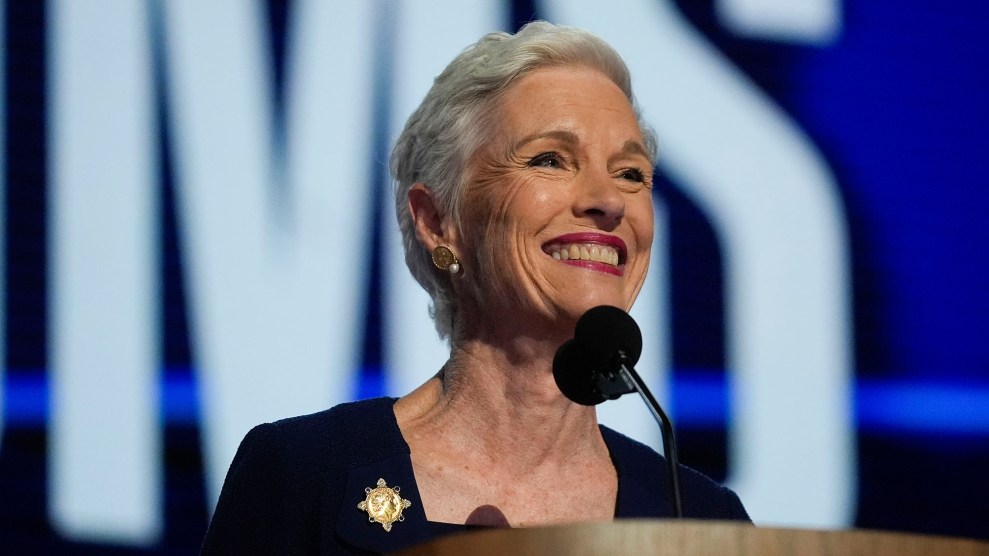In the days following the 2016 presidential election, then–Kansas Secretary of State Kris Kobach and President-elect Donald Trump posed for photographs at the Trump National Golf Club Bedminster in New Jersey. Kobach, an anti-immigration hardliner whose name was being floated to lead the Department of Homeland Security, held a binder and a stack of papers on his left hand. Zoomed-in images revealed the title—“Kobach Strategic Plan For First 365 Days”—and bullet-pointed agenda items that included reinstating a Bush-era registry for immigrants based on religion, ethnicity, and nationality and cutting off the resettlement of Syrian refugees in the United States.
Hassan Ahmad, an immigration lawyer running a small law firm in Virginia, was familiar with Kobach’s longtime efforts to curb immigration. Kobach had championed the infamous “show me your papers” law in Arizona that encouraged racial profiling by instructing law enforcement to request proof of citizenship or legal status from people suspected of being undocumented during routine traffic stops or other police interactions. He was also the mastermind behind 2012 Republican presidential candidate Mitt Romney’s dubious “self-deportation” platform, which was premised on the idea that making work and living conditions in the United States worse for unauthorized immigrants would lead them to leave the country voluntarily. For Ahmad, a Pakistani-American, the photo of Trump and Kobach presaged the “kinds of people,” as he put it, who would be calling the shots on immigration at the White House.
“I figured if we’re going to be spending all of our time putting out fires for the next four years, maybe we should look and see where all this is coming from,” Ahmad says. “Who is going to be telling the new administration where the buttons and levers are to turn the immigration machine into a deportation machine?”
Soon after he saw the Trump and Kobach photo, Ahmad set out to discover who was, in his words, “the flamethrower.” That same month, he learned from a New York Times article that John Tanton, the nativist founder of prominent anti-immigration organizations, had donated a trove of documents to his alma mater, the University of Michigan, in the 1980s. With the help of an associate, Ahmad glanced through the papers’ titles listed on the website of the school’s Bentley Historical Library. Among the “really scary stuff” they saw was a reference to a box containing nine folders with 14 years’ worth of material related to the Pioneer Fund, a foundation established in 1937 to promote eugenics and “race science.”
The more he read, the more concerned Ahmad became. The organizations Tanton founded include the lobbying group Federation for American Immigration Reform (FAIR) and the think-tank Center for Immigration Studies (CIS)—both of which the Southern Poverty Law Center has designated as hate groups—as well as their grassroots counterpart NumbersUSA. These groups had close ties to central figures in Trump’s inner circle for immigration policy. “At the time, I didn’t appreciate the centrality of his role in building the anti-immigrant movement,” Ahmad says, “and the outsize influence that he continues to enjoy over immigration discourse to this day.”
The John Tanton Papers are stored in 25 cardboard boxes containing correspondence, memos, legal filings, news clips, and photographs—documents dating from 1960 to 2007 that illuminate Tanton’s relentless fundraising efforts and reveal that he “was obsessed with white nationalism,” Ahmad says. But only part of the archive is currently available to the public. Tanton died in 2019, but under a gift agreement he reached with the University of Michigan, boxes 15 through 25 are required to remain sealed until April 6, 2035. Besides records related to the Pioneer Fund—which donated more than $1 million to FAIR between the mid-1980s and early 1990s—and other private correspondence, the remaining boxes are said to contain several folders on immigration issues, including the minutes from meetings of FAIR and its legal arm, the Immigration Reform Law Institute (IRLI), where Kobach has served as senior counsel.
“If they are even remotely as informative as the first 14 boxes, there will be some incredibly damning facts to come out,” says Devin Burghart, executive director of the Institute for Research and Education on Human Rights, a social justice organization that aims to combat white nationalism and nativism. Burghart had looked into the Bentley Library archive for years, and in 2017, he shared the roughly 5,000 digitized items that are currently accessible with Ahmad, who had become convinced these papers were in the public interest and should be unsealed—a quest that would turn into an ongoing lengthy legal battle going all the way up to the Michigan Supreme Court and across two administrations.
“What’s in those boxes they don’t want us to see?” Ahmad says. If what is known of Tanton’s anti-immigration crusade has provided a blueprint for many of the most restrictive policies of the past and present, Ahmad wonders, could the secret papers provide more clues about his proposed playbook for the future? Even with Trump out of the office and President Joe Biden attempting to expurgate some of the most harmful features of his predecessor’s policies, lawyers and activists like Ahmad are under no illusion that Tanton’s legacy will be purged. That’s what has impelled Ahmad to fight the University of Michigan for access to what he believes would be a “disinfecting” dose of information.
Root out #WhiteNationalism wherever it may be hiding.
Racist mastermind John Tanton shrouded his dark vision in secrecy, but sunlight is the best disinfectant.
RT and sign the petition to demand @UMich release the #TantonPapers now, not 2035!https://t.co/3YDcbjOpAN pic.twitter.com/DehEOJpGVh
— Hassan Ahmad (@HMAesq) August 9, 2019
“They’ve been able to do things and achieve success no matter who’s in the White House, and they’re not going anywhere.” Ahmad says. “We ignore these groups at our own peril.”
Ahmad first filed a Freedom of Information Act request with the University of Michigan on December 14, 2016, in order to gain access to the Tanton papers. “The organizations founded and/or nurtured by Dr. Tanton currently control and/or influence the creation of national US immigration policy,” he wrote. The request cited Kobach, who FAIR president Dan Stein said at the time “would be an invaluable asset” for the Trump administration, and his ties to the Tanton network through the IRLI. (Kobach has received political contributions from a PAC connected to Tanton and his wife to kickstart his career and later run for governor of Kansas.) “These public writings constitute the architectural foundation of policy that, through Kobach, currently informs the new White House,” Ahmad wrote.
As it turned out, it wasn’t just Kobach. During his time in office, Trump appointed several anti-immigration hardliners with links to white nationalists and the Tanton network to key positions in his administration. Julie Kirchner, a lawyer and former executive director of FAIR, served as an adviser at US Customs and Border Protection and later as ombudsman of US Citizenship and Immigration Services, the agency in charge of legal immigration. Under her leadership, FAIR had lobbied to eliminate the 14th Amendment’s birthright citizenship provision—one of Tanton’s aspirations—and supported several bills to curtail legal immigration, a goal she shared with Trump’s top immigration adviser, Stephen Miller. Another example is Jon Feere, a legal policy analyst at the Center for Immigration Studies who became an adviser to Thomas Homan, acting director of Immigration and Customs Enforcement under Trump and now an IRLI senior fellow, and worked closely with Miller to amplify narratives linking immigrants to higher crime rates.
With Trump as president, these groups capitalized on their unprecedented influence to realize their restrictionist agenda. From the travel ban on Muslim-majority countries to the border wall, Ahmad started seeing policies that had been “hatched and honed for the past 40 years come into effect.” These policies, he realized, could all be traced back to John Tanton.
Born in Detroit in 1934 to an immigrant father from Canada, Tanton was an ophthalmologist, birdwatcher, and beekeeper whose initial activism revolved around environmental conservation and population control. In 1964, he founded a chapter of Planned Parenthood in northern Michigan “to help people not have kids that they didn’t want to have.” Later, he led the organization Zero Population Growth (now Population Connection) and chaired the Sierra Club National Population Committee.
With the baby bust of the 1970s, Tanton shifted his focus to immigration as another driving force of US population growth, tapping into the racialized notion that Latin American migrants had higher fertility rates. But he found that it was a “forbidden topic” and if “anything was going to happen, I would have to do it myself,” he said in his 1989 oral history. Tanton, who described himself as “not particularly bright” but persistent, decided to make restricting both legal and illegal immigration a legitimate and acceptable subject of discussion for Americans.

Behind the scenes, Tanton and his network engaged in an all-encompassing assault on immigration. In 1974, he wrote to a Rutgers University professor asking about the possibility of eliminating birthright citizenship under the 14th Amendment, to which the response was: “Forget it. Build an Iron Curtain—a Berlin wall. That’s your only real hope.” Tanton also suggested that the best solution to the “refugee problems” in the United States was repatriation and funneled resources to groups that campaigned for the passage of California’s Proposition 187 in 1994, which denied undocumented immigrants access to public health, education, and social services. (It was later declared unconstitutional.)
When Tanton founded FAIR in 1979, immigration was not yet a national story, remaining mostly circumscribed to border states like Texas and California, says Carly Goodman, an immigration historian at La Salle University. Earlier overtly racist policies aimed at restricting immigration, such as the Chinese Exclusion Act of 1882 and a 1924 law imposing national origin quotas, had fallen out of favor and given way to other desirability metrics that benefited skilled workers, families, and refugees. Tanton understood that in order to succeed, he would have to rebrand and “sanitize what restriction means,” Goodman says. His approach, she explains, was twofold: deemphasize racial animus by highlighting data, and build consensus and create a culture war around the issue of illegal immigration. More than facts, Tanton believed that “it is emotion that drives action,” he wrote in a 1995 memo.
In likeminded anti-immigration zealots like heiress Cordelia Scaife May, Tanton found the financial support he needed to execute his vision, made public in a series of controversial leaked memos, of exercising influence over Congress and the judiciary. The Pittsburgh-based Colcom Foundation, started by May in 1996, has donated more than $150 million to groups within the Tanton network, primarily FAIR and NumbersUSA. In 1996, FAIR lawyer Cordia Strom worked so closely with Rep. Lamar Smith (R-Texas) on drafting the Illegal Immigration Reform and Immigrant Responsibility Act, which laid the foundation for the present-day mass deportation and detention system, that she was later credited with writing it herself. Efforts by NumbersUSA have also proved instrumental in killing bipartisan immigration reform attempts under George W. Bush and Barack Obama. These groups’ legal action, lobbying, and media appearances have led them to be described as “the most effective political advocacy organizations of the last century” and Tanton as “the most influential unknown man in America.”
As Tanton advanced his margins-to-mainstream strategy of immigration restriction, he increasingly put his racist and xenophobic views and affinity for white nationalism on full display. In his writings, he argued in favor of “passive eugenics,” promoting limiting childbearing to ages 20 to 35 and reducing the size of families as a way to “improve the potential of minority groups.” The publishing house he founded in 1990, the Social Contract Press, published the English-language version of the xenophobic French dystopian novel The Camp of the Saints, a must-read among white supremacists. In a letter to the author of a 1995 academic paper stating that the United States would benefit from diversity, Tanton wrote, “Does the addition of Santeria and voodoo help things out? How about a larger Muslim population, with all the conflict that applies for some of our values?” Tanton often darkly warned of the decline of America triggered by a “Latin onslaught” and the replacement “by more reproductively vigorous stock from abroad,” adding, “I want my posterity to be on the scene.”
“This idea that the dominant culture of the country might be changing,” Goodman says, was another way Tanton helped Americans embrace nativist policies. For him, the mythology of America as a nation of immigrants was an enemy that had to be defeated. In a series of memos from 1986, Tanton explained how immigrants should assimilate by learning English and adopting “our political ideals.” Under the guise of fostering a sense of civic nationalism—which was in fact a not-so-veiled ethno-nationalism—Tanton founded two groups that promoted English-only laws across the country.
He often insisted that his role was “to see over the horizon,” as if intimating the significance of his legacy. “If one hangs in there over a long period of time,” he said in his oral history, “it’s amazing what can be achieved.” Almost 40 years after the founding of FAIR, Trump gave a speech in Arizona as a presidential candidate that echoed much of Tanton’s playbook. He mentioned the need to talk “honestly and without fear” about immigration and to “select immigrants” based on their chances of successfully assimilating, in order to “keep immigration levels measured by population share within historical norms.”
On May 8, 2017, the University of Michigan denied Ahmed’s request to unseal Tanton’s papers. Under the Michigan Freedom of Information Act, the school argued, the sealed papers weren’t “utilized, possessed or retained in the performance of any official University function” and therefore didn’t constitute public records.
Ahmad promptly appealed. Two weeks later, the appeal was also denied, based on the gift agreement between the university and Tanton that prevented the dissemination of the records. Violating the terms of the agreement, the university argued, could have a chilling effect on other “potential donors with key historical documents.”
Ahmad then filed a lawsuit with the Michigan Court of Claims. The court dismissed his suit, but Ahmad appealed, and in the summer of 2019, the Michigan Court of Appeals agreed that the sealed documents are public records and subject to FOIA laws. The university took the case to the Michigan Supreme Court, where its attorney argued the papers don’t shed a light on government activity. Tanton’s initial wish was for his entire archive to be sealed, but the school was able to negotiate a partial release of the records, with the exception of “the final ten feet of the twenty five-foot collection.” The director of the Bentley Historical Library, Terrence J. McDonald, told Michigan Radio that the university was “agnostic about the content” but stood by “the principle that a private individual should be able to give records to a public archive with the expectation that some period of closure can be recognized.”
Several associations representing research libraries and archivists in different states have sided with the university, arguing that honoring requests of “access restrictions” prevents potential donors from withholding or destroying valuable documents. “The risk of destruction is particularly high with controversial figures, such as John Tanton, whose papers might reveal information that could discredit his policy positions,” they stated in an amicus brief filed with the Michigan Supreme Court.
“No one but the university has seen the gift agreement that really is the subject of this entire lawsuit,” Ahmad says. “I haven’t seen it, the judges haven’t seen it, the court hasn’t seen it. At this point, it’s basically their word and nothing more.” Steve Delie, an expert on transparency and open government with the Mackinac Center for Public Policy, says that existing case law makes it clear that public institutions can’t enter contracts that would “relieve them of the obligation to produce otherwise public records under FOIA.”
If the Supreme Court upholds the Court of Appeals decision in favor of Ahmad, the case would go back to trial courts, where the university could hypothetically request exemptions to try to keep all or some of the papers sealed. “I’d be very surprised if the Supreme Court said these are not public records,” Delie said.
Almost 4,000 people have signed an online petition asking the University of Michigan to stop “hiding white nationalist’s papers from the public.” Unsealing the records, says Burghart of the Institute for Research and Education on Human Rights, is in the public interest “to challenge the white nationalism underpinnings of the modern anti-immigrant movement” and “help make the space for real conversations around immigration.” But Goodman is more skeptical of the impact it could have. “I have no doubt that there’s material in those archives that’s even more incendiary,” she says. “But there’s a lot we already know—from congressional hearings and news coverage—that for some reason hasn’t derailed the prominence of these groups. I have asked myself at times: What kind of evidence would finally make visible the harmful ideology that motivates restrictionist immigration views?”
Tanton’s framework has set the tone for the immigration debate for decades, casting immigration as a cost and a threat. FAIR and CIS representatives are constant fixtures on Fox News, and their reports and opinions are cited and published as examples of balanced reporting, almost always without any reference to the organizations’ extremist roots. They have elevated false notions that have been widely taken up by conservatives about terrorists crossing the border and migrants spreading diseases. Recent polls show that Republicans are increasingly supportive of harsher immigration views, even if most of the country is leaning toward more welcoming policies.
“All of us should at least be able to agree that white nationalism and white supremacy should have no place in our immigration policy, and as long as the Tanton network is at the table, that’s exactly what they’re bringing,” Ahmad says. “They’re driven by one thing and one thing alone: to keep America white.”

















